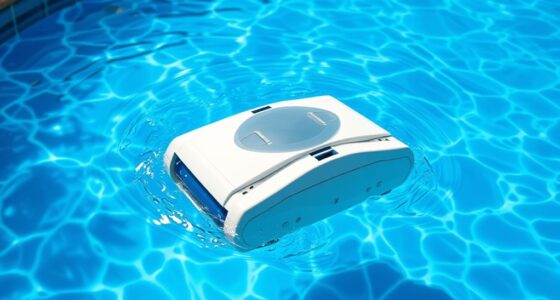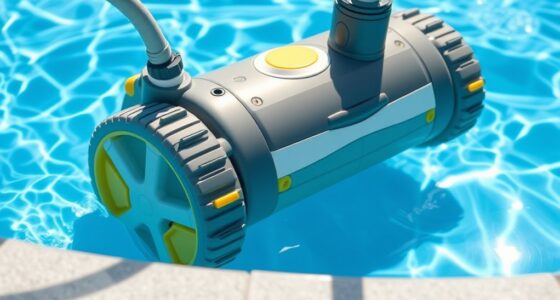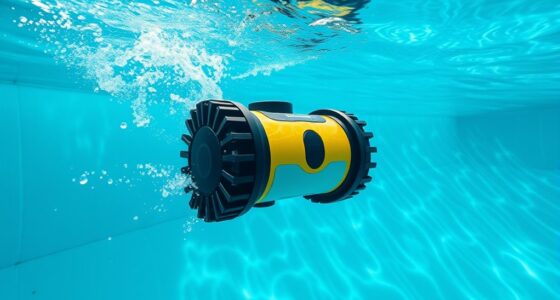Even with automatic pool cleaners, you still need to perform some manual tasks to keep your pool in top condition. Regularly skim the surface, brush the walls and tiles, and check chemical levels to maintain clarity and prevent algae growth. You should also clean skimmer and pump baskets, inspect equipment for wear, and vacuum stubborn debris. Staying on top of these chores helps your cleaner work efficiently and keeps your pool safe. Keep going to find out more tips.
Key Takeaways
- Regularly skim the pool surface to remove leaves and debris that automatic cleaners might miss.
- Brush walls, tiles, and corners to prevent algae buildup and surface stains.
- Check and adjust chemical levels to maintain proper water balance and prevent stains.
- Clean skimmer and pump baskets weekly to ensure optimal filtration and water flow.
- Manually vacuum dead spots and stubborn debris to ensure a spotless, algae-free pool.
Skimming the Pool Surface Regularly
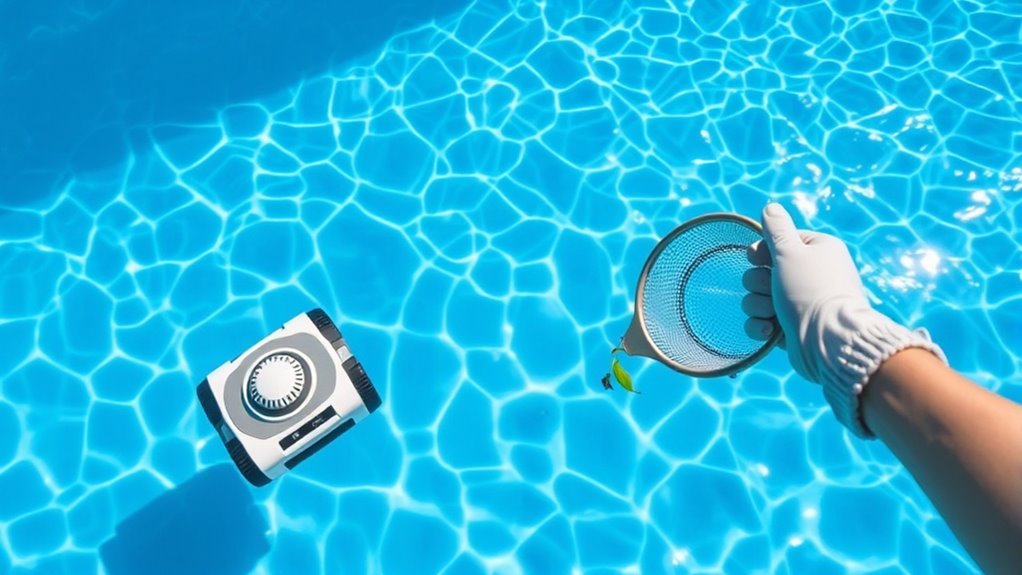
Have you ever wondered why your pool stays cleaner with less effort? Regularly skimming the pool surface is essential. Leaves and debris quickly accumulate, leading to leaf buildup that can clog filters and affect water quality. By removing these surface items daily, you prevent them from sinking and decomposing, which can encourage surface algae growth. This simple task keeps your pool looking inviting and reduces the workload for your automatic cleaner. Using a skimmer or net, make it a habit to remove floating debris at least once a day, especially during windy days or heavy foliage seasons. Consistent surface skimming minimizes organic material in the water, helping to maintain clear, healthy water and easing the overall pool maintenance process. Additionally, proper pool chemistry ensures optimal water balance, preventing algae growth and maintaining clarity, making your pool even more enjoyable. Maintaining good filter performance also depends on removing debris regularly to avoid clogging and ensure efficient operation. Regular cleaning of the skimmer basket also contributes to better automatic cleaner efficiency and prolongs equipment lifespan. Incorporating a routine check of the water circulation system can further improve the overall cleanliness and efficiency of your pool maintenance efforts.
Checking and Adjusting Chemical Levels
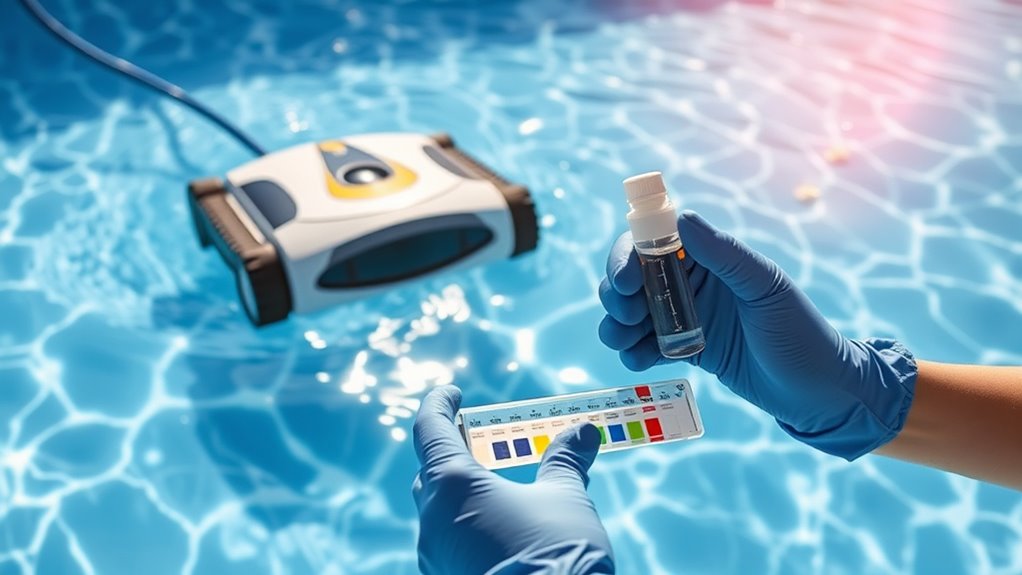
Regularly checking and adjusting your pool’s chemical levels is essential for maintaining safe and clear water. Proper chemical balancing prevents algae growth and skin irritation. Use test kits to monitor pH, chlorine, alkalinity, and stabilizer levels. When needed, perform pH adjustment by adding pH increasers or decreasers. Keep a close eye on your test results and act promptly to correct imbalances. Proper chemical balance contributes to the longevity of your pool equipment and surfaces. Maintaining optimal water chemistry is vital for preventing issues such as cloudy water and equipment corrosion. For more precise adjustments, consider using adjustment tools that help you achieve consistent chemical levels. Additionally, some modern automatic chemical feeders can help maintain stable chemical levels with minimal effort. Here’s a quick reference:
| Chemical | Ideal Range | Adjustment Needed? |
|---|---|---|
| pH | 7.2 – 7.6 | Yes / No |
| Chlorine | 1.0 – 3.0 ppm | Yes / No |
| Total Alkalinity | 80 – 120 ppm | Yes / No |
| Cyanuric Acid | 30 – 50 ppm | Yes / No |
Regular checks ensure your pool stays inviting and safe. Maintaining proper chemical levels is crucial for optimal pool health and longevity.
Cleaning the Skimmer and Pump Baskets

You should regularly inspect your skimmer and pump baskets to keep your pool running smoothly. Clearing out leaves and debris quickly prevents clogs and maintains proper water flow. Keeping these baskets clean is a simple step that makes a big difference in pool maintenance. Additionally, ensuring your equipment is well-maintained can help prevent costly repairs and extend the lifespan of your pool system home maintenance. Incorporating preventive maintenance strategies can help monitor system performance and detect potential issues early, reducing downtime and repair costs. Regularly scheduling professional mechanic shop inspections for your pool equipment can also support optimal operation and early problem detection. Moreover, practicing space and organization techniques, like creating designated zones for tools and supplies, can streamline your maintenance routine and prevent clutter from hindering access.
Regular Basket Inspection
How often should you check the skimmer and pump baskets? Ideally, you should inspect them weekly to prevent clogging and maintain proper filter maintenance. Regular basket inspection guarantees debris doesn’t hinder water flow or damage your pump. When checking, look for:
- Excess leaves and debris blocking the skimmer basket
- Signs of wear or cracks that may require skimmer basket replacement
- Build-up that could strain the pump
- Unusual noises indicating poor circulation
- Cleanliness to keep your pool water clear
Removing debris promptly keeps your automatic cleaner working efficiently. It’s also helpful to familiarize yourself with basic home maintenance practices to ensure your pool equipment remains in good condition. Additionally, understanding the benefits of regular maintenance can help prevent unexpected equipment failures. Incorporating automated monitoring systems can further streamline the process and alert you to issues early. Don’t forget to empty the baskets carefully and reinstall them securely. Consistent inspection prolongs equipment life, prevents costly repairs, and keeps your pool sparkling. Remember, a well-maintained basket supports overall pool hygiene. Additionally, understanding the digital literacy benefits among seniors can help in educating users on proper maintenance routines. Staying informed about technological advancements can also streamline your pool care process.
Clearing Debris Effectively
To keep your pool’s circulation system running smoothly, clearing debris from the skimmer and pump baskets must be done thoroughly and efficiently. Regularly remove leaf accumulation to prevent clogs and guarantee proper water flow. Check the baskets for any debris, insects, or small twigs that could hinder filtration. Clearing out insects caught in the baskets also helps with insect control, reducing potential breeding sites around your pool. Use a net or your hands to remove debris carefully, avoiding damage to the baskets. Rinse the baskets with water to clear out dirt and smaller particles. Proper maintenance procedures are essential for extending the lifespan of your equipment and ensuring optimal operation. By staying on top of debris removal, you’ll maintain ideal filtration, improve water quality, and extend the life of your automatic cleaner. Regular cleaning helps in controlling dirt buildup, which can negatively impact pool performance. Consistent cleaning keeps your pool inviting and safe, and incorporating water circulation techniques can further enhance water clarity and health.
Brushing Pool Walls and Tiles
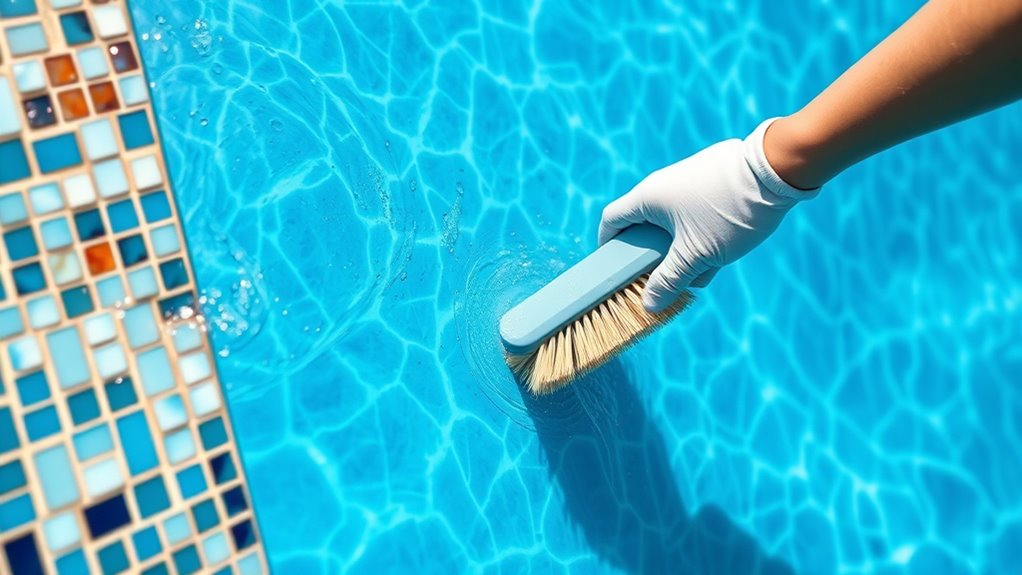
Brushing your pool walls and tiles is key to removing algae buildup before it becomes a problem. It also helps prevent surface stains from forming, keeping your pool looking fresh. Regular brushing boosts overall cleanliness, making your automatic cleaner’s job easier and more effective.
Effectively Removing Algae Buildup
Algae buildup can quickly turn your pool into a slimy mess if not addressed promptly. To effectively remove algae, you need to focus on brushing your pool walls and tiles thoroughly. This physical action helps dislodge algae spores and expose them to chemicals that can eliminate them. Remember, consistent algae prevention starts with proper chemical balancing and routine brushing.
Consider these tips:
- Use a stiff-bristled brush for stubborn algae patches
- Brush all surfaces, including corners and steps
- Maintain proper chemical levels to inhibit algae growth
- Regularly check and adjust pH and sanitizer levels
- Rinse brushes and tools after use to prevent spreading spores
Combining brushing with proper chemical balancing keeps algae at bay and maintains a clean, inviting pool.
Preventing Surface Stains Formation
Surface stains on pool walls and tiles can develop if you neglect regular maintenance, marring the pool’s appearance and making cleaning more difficult over time. To prevent surface stain formation, consistent brushing of the walls and tiles is vital. This removes dirt, algae, and mineral buildup before they cause stains. Alongside brushing, maintaining proper chemical balance is essential; imbalanced water can accelerate stain formation. Regularly test and adjust pH, alkalinity, and calcium hardness levels to keep the water in ideal condition. Using a pool brush weekly ensures you keep surface stains at bay and reduces the need for more intensive cleaning later. By combining surface stain prevention techniques with diligent chemical balance maintenance, you protect your pool’s clarity and extend its lifespan.
Enhancing Overall Pool Cleanliness
Regularly brushing your pool walls and tiles is essential for maintaining overall cleanliness and preventing buildup. This manual task helps remove algae, dirt, and calcium deposits that automatic cleaners might miss. Keeping your pool surfaces clean supports proper pool chemistry, ensuring balanced pH and chlorine levels. It also enhances pool safety by reducing slip hazards and preventing algae growth. To maximize effectiveness, consider these tips:
- Use a stiff-bristled brush for stubborn spots
- Focus on corners and waterline tiles
- Check for algae or calcium deposits regularly
- Clean your brush after each use
- Maintain consistent brushing schedule
Vacuuming Dead Spots and Stubborn Debris
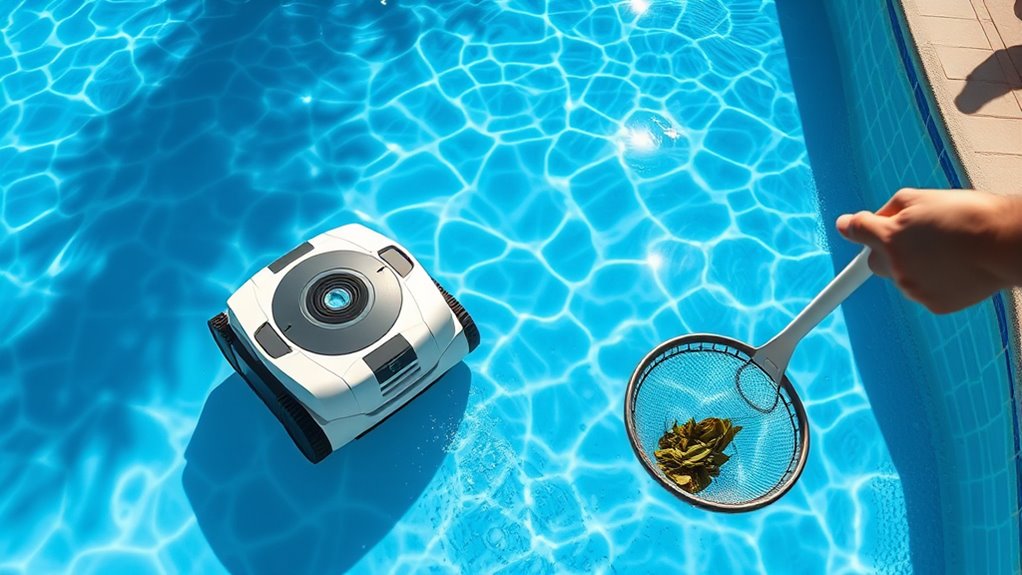
Even with automatic pool cleaners, some areas can be tough to keep spotless, especially dead spots where debris tends to settle and stubborn patches of dirt. To guarantee these areas stay clean, you’ll need to perform manual vacuuming for targeted debris removal. Using a handheld or pole-mounted vacuum allows you to reach corners, steps, and under pool fixtures that automatic cleaners might miss. Focus on these stubborn spots regularly, especially after storms or heavy usage, to prevent dirt buildup. Manual vacuuming not only improves water clarity but also reduces algae growth and prevents long-term debris accumulation. While automatic cleaners do most of the work, occasional targeted manual vacuuming is essential for maintaining a truly spotless pool, especially in those tricky dead spots.
Inspecting Pool Equipment for Wear and Tear
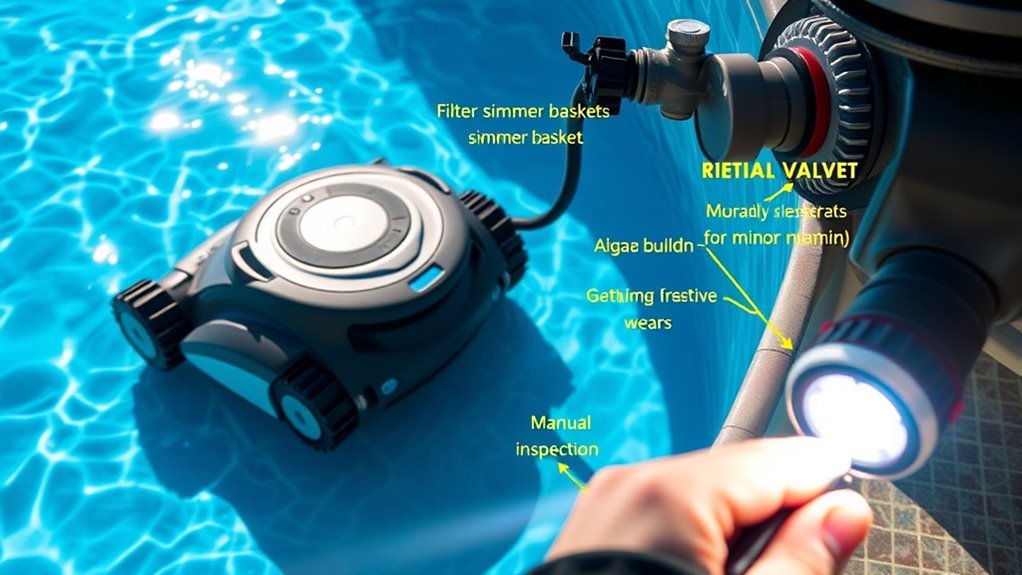
Inspecting your pool equipment regularly is essential to guarantee everything functions smoothly and to prevent costly repairs. Focus on evaluating equipment durability and performing wear assessment to catch issues early. Look for signs like cracks, corrosion, or loose fittings that could compromise performance. Check the pump, filter, and skimmer for leaks or damage. Ensure hoses and seals are intact and flexible. Listen for unusual noises indicating worn bearings or motor problems. Regular inspection helps you identify worn parts before they fail, extending the lifespan of your equipment.
- Cracks or corrosion on pumps and filters
- Loose or damaged fittings and seals
- Worn or frayed hoses
- Unusual noises or vibrations
- Signs of leaks or rust
Monitoring Water Levels and Adding Water When Needed
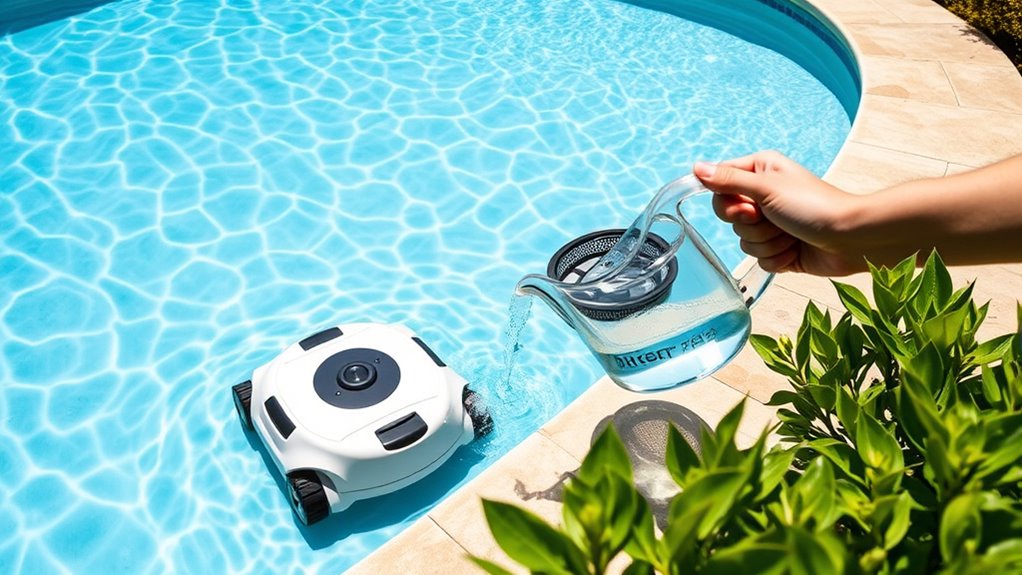
Monitoring your pool’s water levels is essential to maintain proper circulation and sanitation. If the water drops below the skimmer line, you need to perform water addition procedures to prevent pump damage and ensure efficient filtration. Proper water level management keeps your automatic cleaner running smoothly and extends equipment lifespan. Regularly check the water level, especially after heavy use or rain. When adding water, use a garden hose and avoid overfilling to prevent spills and water waste. Keep a simple chart handy to track your water level adjustments:
| Water Level Status | Action Needed | Tips |
|---|---|---|
| Below skimmer | Add water gradually | Use hose at low pressure |
| At recommended level | No action needed | Check weekly |
| Slightly above | Drain excess if needed | Use a bucket or drain valve |
Covering the Pool When Not in Use
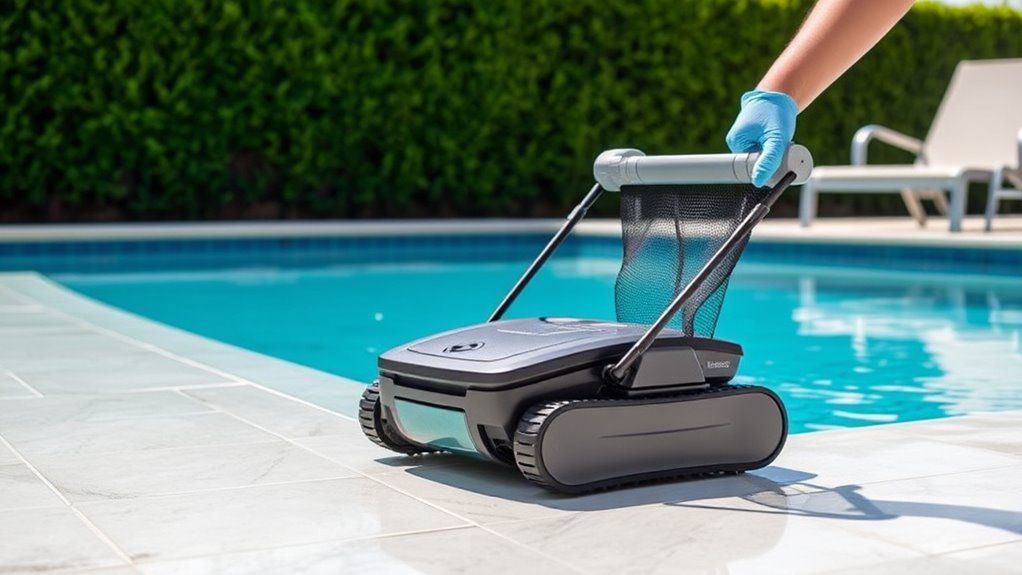
Covering your pool when it’s not in use helps keep debris out of the water and maintains water quality. A proper pool cover reduces the need for frequent cleaning and conserves chemicals. There are various pool cover types, including solid safety covers, mesh covers, and automatic covers. Each offers different benefits, like safety, durability, or ease of use. When selecting a covering pool option, consider your budget, climate, and maintenance preferences.
- Prevents leaves, dirt, and insects from falling in
- Reduces water evaporation
- Keeps the water warmer
- Enhances safety by preventing accidental falls
- Simplifies regular cleaning and maintenance
Choosing the right pool cover type helps keep your pool cleaner and safer year-round.
Frequently Asked Questions
How Often Should I Manually Check My Pool’S Chemical Levels?
You should check your pool’s chemical levels at least once a week through pool water testing. Regular testing helps you maintain proper chemical balancing, ensuring safe and clean water. If you notice heavy use or after a storm, test more often. Proper chemical balancing prevents algae growth and keeps your pool inviting. Don’t skip these manual checks, even with automatic cleaners—staying on top of chemical levels is key to easy pool maintenance.
What Are Signs That Pool Equipment Needs Repair?
Sometimes, signs of trouble appear when you least expect them. If your pool’s water isn’t clear, the pump makes unusual noises, or you notice weak flow, it’s time for pool filter maintenance and pump troubleshooting. Leaks, persistent odors, or equipment cycling irregularly also signal repair needs. Addressing these early prevents bigger issues, ensuring your automatic cleaner works seamlessly and your pool stays inviting.
How Do I Safely Brush Delicate Pool Tiles?
When it comes to pool tile cleaning, you want to protect delicate surface care. Use a soft-bristled brush or a sponge to gently scrub the tiles, avoiding harsh scrapers that could damage the surface. Always dip your brush in a mild cleaning solution or water to prevent scratching. Work slowly and carefully, focusing on buildup without applying excessive pressure, ensuring your delicate tiles stay pristine and undamaged.
When Is the Best Time to Vacuum Stubborn Debris?
You should vacuum stubborn debris early in the day, especially after leaf removal and skimmer maintenance. Doing this when debris is dry makes it easier to pick up and prevents clogging your automatic cleaner. Check your skimmer basket and remove any leaves or buildup first, so it doesn’t interfere with vacuuming. Regularly maintaining the skimmer and removing debris helps keep your pool clean and makes manual vacuuming more effective.
How Can I Prevent Algae Growth Without Chemicals?
You might think algae can’t grow without chemicals, but natural algae prevention methods work too. Regularly brushing your algae-resistant pool surfaces helps remove spores before they settle. Ensuring proper circulation and sunlight exposure discourages algae growth naturally. You can also use natural remedies like algaecide alternatives or adding enzymes. These methods keep your pool clear without harsh chemicals, maintaining a healthy environment and reducing algae buildup effectively.
Conclusion
Even with automatic cleaners doing much of the work, your pool still needs your attention. Skimming, checking chemicals, and inspecting equipment are essential steps you can’t skip. Missing just one task could lead to bigger problems down the line. So, are you ready to stay ahead of potential issues and keep your pool sparkling? Remember, a little effort now can save you a lot of trouble later—trust me, the surprises might not always be pleasant.


